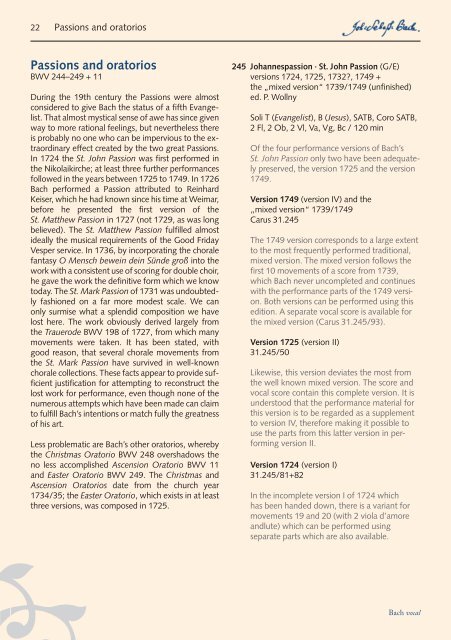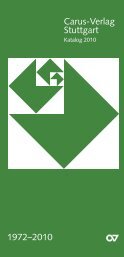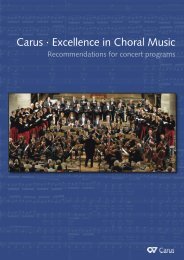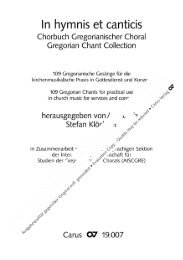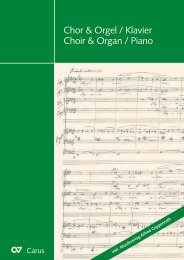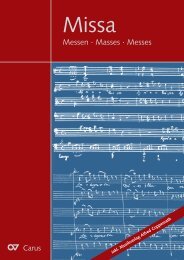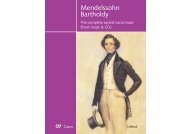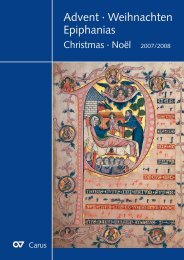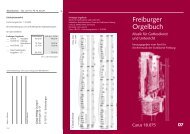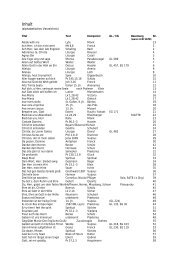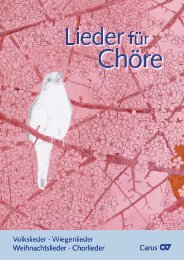Cantatas · Masses · Oratorios Passions · Motets
Cantatas · Masses · Oratorios Passions · Motets
Cantatas · Masses · Oratorios Passions · Motets
Create successful ePaper yourself
Turn your PDF publications into a flip-book with our unique Google optimized e-Paper software.
22 <strong>Passions</strong> and oratorios<br />
<strong>Passions</strong> and oratorios<br />
BWV 244–249 + 11<br />
During the 19th century the <strong>Passions</strong> were almost<br />
considered to give Bach the status of a fifth Evangelist.<br />
That almost mystical sense of awe has since given<br />
way to more rational feelings, but nevertheless there<br />
is probably no one who can be impervious to the extraordinary<br />
effect created by the two great <strong>Passions</strong>.<br />
In 1724 the St. John Passion was first performed in<br />
the Nikolaikirche; at least three further performances<br />
followed in the years between 1725 to 1749. In 1726<br />
Bach performed a Passion attributed to Reinhard<br />
Keiser, which he had known since his time at Weimar,<br />
before he presented the first version of the<br />
St. Matthew Passion in 1727 (not 1729, as was long<br />
believed). The St. Matthew Passion fulfilled almost<br />
ideally the music al requirements of the Good Friday<br />
Vesper service. In 1736, by incorporating the chorale<br />
fantasy O Mensch bewein dein Sünde groß into the<br />
work with a consistent use of scoring for double choir,<br />
he gave the work the definitive form which we know<br />
today. The St. Mark Passion of 1731 was undoubtedly<br />
fashioned on a far more modest scale. We can<br />
only surmise what a splendid composition we have<br />
lost here. The work obviously derived largely from<br />
the Trauerode BWV 198 of 1727, from which many<br />
movements were taken. It has been stated, with<br />
good reason, that several chorale move ments from<br />
the St. Mark Passion have survived in well-known<br />
chorale collections. These facts appear to provide sufficient<br />
justification for attempting to reconstruct the<br />
lost work for performance, even though none of the<br />
numerous attempts which have been made can claim<br />
to fulfill Bach’s intentions or match fully the greatness<br />
of his art.<br />
Less problematic are Bach’s other oratorios, whereby<br />
the Christmas Oratorio BWV 248 overshadows the<br />
no less accomplished Ascension Oratorio BWV 11<br />
and Easter Oratorio BWV 249. The Christmas and<br />
Ascension <strong>Oratorios</strong> date from the church year<br />
1734/35; the Easter Oratorio, which exists in at least<br />
three versions, was composed in 1725.<br />
245 Johannespassion <strong>·</strong> St. John Passion (G/E)<br />
versions 1724, 1725, 1732?, 1749 +<br />
the „mixed version“ 1739/1749 (unfinished)<br />
ed. P. Wollny<br />
Soli T (Evangelist), B (Jesus), SATB, Coro SATB,<br />
2 Fl, 2 Ob, 2 Vl, Va, Vg, Bc / 120 min<br />
Of the four performance versions of Bach’s<br />
St. John Passion only two have been adequately<br />
preserved, the version 1725 and the version<br />
1749.<br />
Version 1749 (version IV) and the<br />
„mixed version“ 1739/1749<br />
Carus 31.245<br />
The 1749 version corresponds to a large extent<br />
to the most frequently performed traditional,<br />
mixed version. The mixed version follows the<br />
first 10 movements of a score from 1739,<br />
which Bach never uncompleted and continues<br />
with the performance parts of the 1749 version.<br />
Both versions can be performed using this<br />
edition. A separate vocal score is available for<br />
the mixed version (Carus 31.245/93).<br />
Version 1725 (version II)<br />
31.245/50<br />
Likewise, this version deviates the most from<br />
the well known mixed version. The score and<br />
vocal score contain this complete version. It is<br />
understood that the performance material for<br />
this version is to be regarded as a supplement<br />
to version IV, therefore making it possible to<br />
use the parts from this latter version in per -<br />
forming version II.<br />
Version 1724 (version I)<br />
31.245/81+82<br />
In the incomplete version I of 1724 which<br />
has been handed down, there is a variant for<br />
movements 19 and 20 (with 2 viola d’amore<br />
andlute) which can be performed using<br />
separate parts which are also available.<br />
Bach vocal


